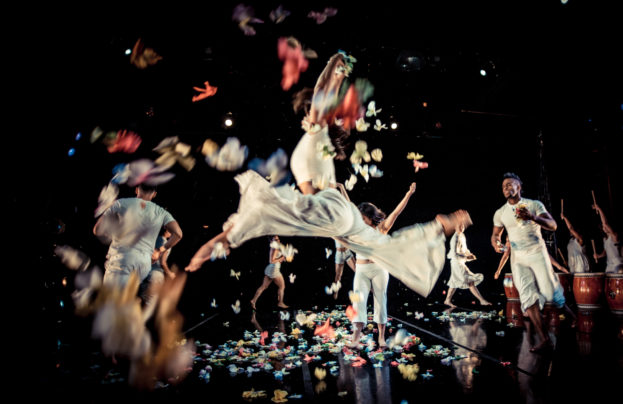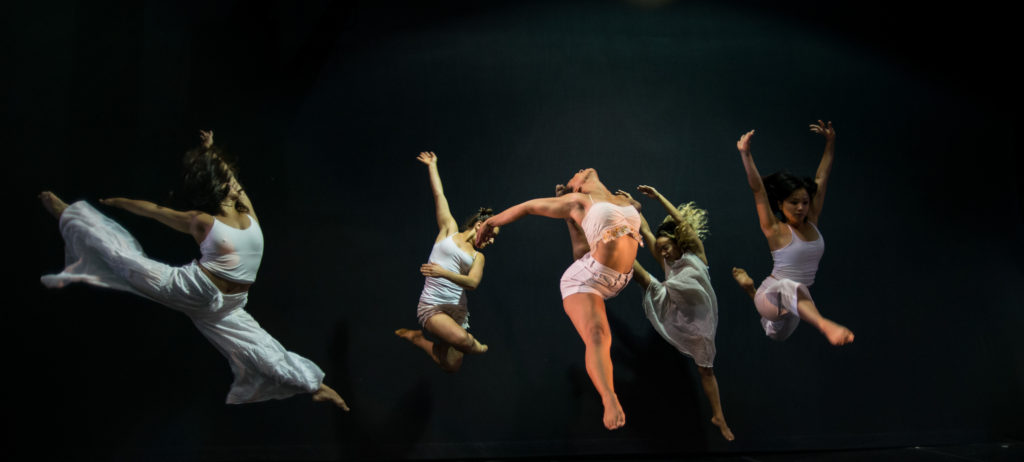
“A collective response of intelligence and resistance together with compassion.” — Krissy Keefer, November 2016
Mission street between 15th and 16th does not get a lot of foot traffic. That stretch can be so oddly quiet that you might even find a parking spot in the middle of the day. Its regulars are local residents, amidst people living on the street finding temporary refuge at the Navigation Center (that, rumor has it, may be replaced by a stack of apartments). Hopefully, the apartments might welcome at least a small percentage of low-income residents. One of these days, several floors of apartments at what is called “market rates” may top it. Yet this sad forgotten part of the beloved Mission has at least one spot of hope.
Above the headquarters of the UFCW648—United Food and Commercial Workers Union Local 648—on the West side of the Street, dozes a long-abandoned meeting room. It may have been the place where the workers’ union once developed common strategies, or paid their dues, or perhaps made a credit union deposit at the now boarded up bank-like cashiers windows. The narrow wooden folding chairs are meticulously lined up, facing a dais with a speaker’s podium and big chairs, no doubt once used by officials. The linoleum may be worn, the air just a mite bit stale; yet I can still sense the spirit of what was a vital community resource years ago.
Not Dance Mission Theater Artistic Director Krissy Keefer, who is my tour guide on this late November morning. Her mind is on the future. “It came in just in time for Thanksgiving, ” she had emailed me from Cincinnati where she spent the holiday.
The “It” is the Letter of Intent for a ninety-nine year lease, which makes a real possibility of Dance Mission Theater/ Dance Brigade leasing the floor above the UFSW648’s ground floor office. They will add two additional floors, perhaps even three, and turn the location into an 18,000 sq. ft. venue. Keefer beams at the idea that she might have more space than she needs. Looking around, she sees that “all of this will have to be torn out, except the load-bearing pillars; I don’t quite know how it will work—that will be the architect’s job.” She already has one in mind.
One thing is certain: Dance Mission Theater will finally become wheel chair accessible. An elevator is definite. Planned are several studios—the ceilings are high, the windows large—and, perhaps a 350-seat theater. What will not change is the model of Dance Mission housing all of its activities under one roof; the classes, the residences, the workshops, the public performances, the home of Dance Brigade and Grrrl Brigade. Keeping prices affordable to audiences, students, artists and dance companies remains essential.
In its current location, Dance Mission has become known for its performances (42 weeks a year), children’s program (350 students enrolled), teenage Grrrl Brigade (85 girls total), and over 550 adults stepping into classes each week — from Hip Hop to Samba, West African to Modern, House Method to Taiko Drumming. With five full-time and three part-time employees, the organization’s budget is close to one million dollars, 75% of which is earned income.
The name ‘Dance Mission’ indicates both a location and a commitment to the neighborhood, but it also affirms an organization for dance that has a mission. Keefer has proven that socially conscious dance theater and aesthetics don’t have to be in conflict. Making “good” political-change art can also be good art. This is certainly one reason why the Dance Brigade has survived, celebrating its 40th anniversary on January 13th and 14th at Yerba Buena Center for the Arts.
Kary Schulman, director of the Grants for the Arts program of the SF Hotel Tax Fund, put it succinctly when she described Dance Brigade “as a unique arts creator— demonstrating the powerful combination of performance and social activism of which Krissy was a pioneer and still one of the most respected practitioners.”
The January celebration will offer the world premiere of Gracias a la Vida (Life in a Bitter Time) for which Keefer had to switch gears halfway through. “Like everybody, I thought Hillary Clinton was going to win,” she remarks, “and now we have a president who is a climate change denier.” But the thrust of what she calls “an artistic response to the collective crisis that the country is in,” has not been derailed. The cast includes ten women, three men and two male musicians.
Gracias, she explains, “examines human connections when the truth does not feel that good.” Love places a central role, but not the goody-goody, sentimental variety. Unlike previous endeavors with long-time collaborators, for this production Keefer chose a cast with whom she has not worked extensively. Men and women. She even auditioned some of the performers—a first for her. She is again working with long-time friend, singer Holly Near. They are reaching back to folk and protest songs from the 1960s and earlier that still resonate today. Think Woodie Guthrie’s Deportee and Neil Young’s Southern Man.
Keefer cut her theatrical/dance teeth with the Wallflower Collective in Eugene Oregon, a radical feminist group that outgrew its home base and, after an unhappy move to Boston, relocated to San Francisco because its members wanted to be in an urban (West Coast) environment. As it turned out, it was not exactly a happy decision: the move destroyed Wallflower. Keefer recalls San Francisco’s volatile political environment of the 1970’s where you were expected to decide on whether to support the Workers World Party, non-intervention in Chile, Cuba’s revolution or the Palestinians. “We were not prepared for how vicious those discussions could get,” she remembers. “We were like milkmaids from Oregon.”

So, forty years ago, Keefer (together with deceased friend and colleague Nina Fichter) founded Dance Brigade. The troupe has admirably succeeded in creating Dance Theater that powerfully speaks to the heart and the mind, the individual and the collective. Keefer is an excellent writer and actor. She always weaves a sense of humor and a glimmer of hope into even the most desperate scenarios. A cursory glance at some of what has been accomplished gives an idea of the vitality and breadth of these fearless warriors:
- The Revolutionary Nutcracker Sweetie (1987). Probably the most inclusive dance theater works at the time. It still thrives in a Grrrl Brigade version.
- Sleepwalker (1990), exploring women and alcoholism.
- Pandora’s Box (1991), a not so modest history of womankind
- Cinderella – a tale about domestic abuse and resistance
- Ballet of the Banshees. . . (1995) ends with a healing ritual for women and breast cancer.
- Queen of Sheba (1999), Keefer’s solo on the power of the female body and its prophetic voice
- Dry/Ice (2005), a work about global warming with a bathtub and plastic bottles.
- Iphigenia at Aulis (2006), Dance Brigade as a Greek Chorus in Euripides’ play
- The Great Liberation Upon Hearing (2009), accompanied Lena Gatchalian through the Tibetan Book of the Dead. The only place on stage you’ll ever encounter a real pig’s head.
- Hemorrhage: An Ablution of Hope and Despair (2014), looking at displacement caused by rapacious real estate developers.
Starting a fifth decade in shaping Bay Area dance, Keefer could reasonably think about retirement. She has considered it, but it is not in the cards. For one thing, she has been buoyed by the many non-profits and governmental agencies that have been so positive about Dance Mission taking on a 99-year lease. This includes a looming capital campaign ($6,000,000) for which they’ll have to hire a Capital Development Manager (a Dance Mission first). Among others, Keefer credits MEDA (Mission Economic Development Agency) for assistance in the complex lease negotiations. Lex Leifheit Nonprofit Business Development Manager of the Office of Economic & Workforce Development explains the City’s support: “Dance Mission’s core values of inclusiveness, fairness and justice reflect San Francisco’s values and the spirit of advocacy embodied by many nonprofits here.” Schulman elaborates her evaluation for “a group that has an enviable record of earned income and sound management. DB/DM is an irreplaceable community asset!”
Keefer estimates that the remodeling will take about three years. In the meantime, she has plans for Dance Brigade. “I may want to change directions,” she laughs, volunteering that she has been reading a lot about Diaghilev. Apparently, it has helped her rediscover her love for ballet. She is working with a group of beautifully trained Cuban dancers in their twenties, who would like to have more opportunities creating and performing.
Both a passionate idealist and a realist, Keefer believes that “the rise of Misty Copeland has changed the aesthetics of ballet. It has moved away from the emaciated 19-year old, 110-pound dancer.” Ballet in the future, she projects, “can have breasts and hips, and women can show muscles. For too long it has been androgynous with [female dancers] muted in their energy field. So it’s exciting for me to participate in what has been shut to me all these years. Misty has saved ballet because it is going to be more interesting. It will no longer be based on a singular aesthetic.”
The artist-led model of dance companies, she also believes, is no longer sustainable. So she is looking back to Diaghilev where ballerinas not only looked like her, but where ballet, in addition to visual and musical collaborators, engaged a variety of choreographers. She already has in mind several local artists whom she would like to commission. “I am going to be the next Diaghilev,” Keefer gleefully asserts. She just might be right.
This article appeared in the January/February 2017 issue of In Dance.


